Thank you Cheryl (Cuillier) Casey, Emily Ford, Nathan Smith, Rich Hershman, and Jonathan Poritz for help with Consumer Price Index data.
Executive Summary
When we talk about the cost of textbooks at Oregon’s community colleges, how much money are we really talking about? In 2015, 2017, 2019, and 2021, Open Oregon Educational Resources gathered locally relevant cost data that could be compared over time. The results show that during the six years that Oregon has invested statewide funding in textbook affordability, our community colleges have significantly reduced the cost of course materials for two-year transfer degrees.
Key takeaways:
- Oregon’s statewide investment in textbook affordability pays off in lower costs to students.
- As we gain evidence that there are viable models to lower costs for students without compromising on quality, we can reconsider the role of the campus store.
- Future research will include not only student savings but also measures of quality and student experience.
Key findings:
- The average materials cost for the two-year Associate of Arts Oregon Transfer (AAOT) degree in 2021 is $1,143.62, a 23% drop since 2019 and a 47% drop since the study began in 2015.
- Approximately 100,000 students in the 10 highest-enrolled courses statewide saved an estimated $1.6M in 2021, compared to 2019 costs.
- The lowest-cost pathway through the AAOT degree requirements averages $203.63 in course material costs for a two-year degree.
The findings of this ongoing study show that statewide, average materials costs for transfer degrees continue to fall, and that Oregon is well below the national benchmark published by the College Board. Prominently designating no-cost and low-cost courses in the schedule enables students to make informed choices as they plan their term. This study demonstrates that students are benefitting from a statewide investment in lowering the cost of course materials and that further research on measures of quality and student experience will be relevant to Oregon faculty. Download a PDF.
Background
The present study is the fourth time that this research project on the cost of course materials for transfer degrees in Oregon has been done. Each time, Open Oregon Educational Resources uses a research method conceived by Quill West, Pierce College’s Open Education Project Manager, and refined by Nicole Allen, Director of Open Education at SPARC.
- The 2015 blog post from the beginning of this project, titled Why do we need this research?, argued that Oregon needs local data in order to understand the scope of the problem that our textbook affordability program has set out to solve.
- In 2015, What is the cost of course materials for a transfer degree at each community college in Oregon? provided a detailed writeup on the method and baseline results of the first round of research.
- In 2017, Two years and a big difference: Transfer degree course materials costs are down at Oregon’s community colleges showed that estimated costs fell as textbook affordability initiatives in Oregon’s colleges grew. In addition, by 2017 most Oregon colleges had implemented no-cost and low-cost course material designations in the schedule as a result of HB 2871, so it was possible to determine the lowest-cost pathway through the degree requirements.
- In 2019, Four years and falling: Impact of statewide funding for textbook affordability offered a consistent comparison of costs over time. While commercial textbook prices fell in response to market pressures, the cost of course materials for transfer degrees in Oregon dropped even more steeply.
The present study shows the continuation of these trends and demonstrates that Oregon’s investment of public funds in textbook affordability is well spent.
The Future of This Study
What does it mean to report on essentially the same results three times in a row? After the baseline results of the first round of research, the trend is clear: Oregon’s investment of public funds in textbook affordability has a measurable impact. Course materials costs are down for community college students, and falling faster than what we would see if they tracked with national trends.
First of all, this is excellent news for community college students. Kudos are due to the instructors who have redesigned their courses to incorporate low-cost or free course materials, and the teaching and learning support staff who help them do so.
Second, it is worth asking whether ongoing research is needed when the results are already clear. This is an open question. Perhaps the 2023 round of this study will downsize the method to provide a check-in on costs rather than a deep dive.
Third, further research on measures of quality and student experience will be relevant to Oregon faculty. These metrics are more difficult to measure and squishier to report on; as with any educational research, there will be confounding variables limiting our conclusions. However, it is worthwhile to ensure that course materials are not just affordable, but also high quality: relevant, aligned with course outcomes, accessible, and designed with an equity lens.
Campus Stores as Partners in Innovation
This project would not have been possible without the assistance of all 17 of Oregon’s community college bookstore managers in verifying the data gathered at each institution. Store managers are valued campus community members who bring expertise in negotiating with publishers, on-demand printing, and compliance with federal reporting requirements in order to support students.
At many institutions, this is a difficult time to be a campus store manager. The National Association of College Stores finds that student spending has decreased in most years since 2007, regardless of whether textbook prices were increasing or decreasing (although in 2020-21, in the midst of the pandemic, student spending increased because of lack of access to cheaper alternatives such as sharing, library reserves, peer-to-peer swaps, and so on). While the revenue loss began years ago with students using Amazon, Chegg, and other strategies to control spending, campus- and state-led efforts to lower costs also have an impact on the bottom line.
It is an essential service for students to find and purchase their course materials where they can use their financial aid and other benefits. But reduced revenue calls into question the self-support model that all of Oregon’s stores currently operate under, and has led to several of Oregon’s independent college stores being outsourced. In order to explore viable models to lower costs for students without compromising on quality, Open Oregon Educational Resources hosts an ongoing webinar series on innovative campus store models:
- Innovative Textbook Procurement Models
- Minnesota State Colleges and Universities Bookstore Collaboration: The Power of Ourselves
- Library/Bookstore Integration at Columbia Gorge Community College.
Research Method
This analysis estimates course materials costs for Oregon’s highest-enrolled transfer degree program, the Associate of Arts Oregon Transfer (AAOT).1 While there are some specific courses required for the AAOT, there are many possible ways to meet the requirements for disciplinary studies and electives. Therefore, where there were multiple options to meet a requirement, the course with the highest enrollment at that college was selected to fulfill the requirement. Data on course enrollments for each college was provided by the Office of Research and Data of the Oregon Higher Education Coordinating Commission from the most recent year available (2019 for the present study). This research does not suggest a pathway that any individual would take, but rather looks at the courses that students collectively take most often at each college.
The next step was to visit each college bookstore’s website and look up the required course materials for each of the courses for the current term. If multiple sections of the course were being taught, the first one on the list was selected. This arbitrary choice accounts for the fact that students often are not able to choose their courses based on cost of materials because of competing priorities such as work schedules or childcare.
For each course, the most and least expensive options for the total cost of materials was recorded. If one book could be used for more than one course in a series, its cost was only counted once. The research method described so far was repeated in 2015, 2017, 2019, and 2021 in order to make a consistent comparison.
An additional analysis was added beginning in 2017. Oregon’s HB 2871 (passed in 2015) requires all public colleges and universities to designate no-cost and low-cost courses in the schedule. This policy assumes that students may make course selections based on the cost of materials. This makes it possible to use the schedule to find the AAOT degree pathway with the lowest possible materials cost. Again, this is not a program that any individual would pursue, but demonstrates the significant cost savings that are possible when students have the information and flexibility to choose the lowest-cost option.
This study doesn’t ask what students actually spend (which includes strategies such as sharing, borrowing, pirating, doing without course materials altogether, and so on). Rather, this study measures what students are asked to spend by looking at the cost of course materials adopted through the bookstore. A research report recently released by the Midwestern Higher Education Compact, Toward convergence: Creating clarity to drive more consistency in understanding the benefits and costs of OER, agrees with this reasoning, stating that student savings estimates should assume that all students have equitable access to the course materials; adjusting for actual student behavior can reinforce inequity by building in an assumption that some students will continue to have limited or no access to required materials that are needed to succeed in the course.
Results
At every college but one, the cost of course materials for an AAOT degree is down, which reflects the work undertaken over the past six years to lower textbook costs. Choosing the first section of the highest-enrolled courses to meet degree requirements, the statewide average cost is $1,143.62. This average represents:
- 23% drop since 2019
- 37% drop since 2017
- 47% drop since 2015.
Assuming maximum flexibility to select courses based on materials cost, the average lowest-cost AAOT degree pathway is $203.63. This very low number represents 82% savings compared to the average cost when always choosing the first section, demonstrating the significant savings that are possible when students have the information and flexibility to choose the lowest-cost option.
Figure 1, below, shows the statewide average cost of materials for the AAOT degree (averaging the high and low materials costs for the degree) in the four years that data were gathered.
Chart details: Statewide average cost of materials for AAOT and lowest-cost AAOT pathway (averaging the high and low materials costs for the degree) in the four years that data were gathered. For the AAOT, the statewide average in 2015 was $2142.84; in 2017 it was $1810.26; in 2019 it was $1492.15; in 2021 it was $1,143.62. For the lowest-cost AAOT pathway, the statewide average in 2017 was $461.48; in 2019 it was $381.24; in 2021 it was $203.63.
According to the Oregon Community Colleges Data Mart, 3,470 students completed AAOT degrees in 2020-21 (the most recent year available). An average savings of $348.53 compared to 2019 costs adds up to a statewide estimated savings of $1,209,399.10 for the students that completed their AAOT degree last year. If they were all able to pursue the lowest-cost degree pathway, those graduates would see an additional savings of $3,261,765.30.
Comparisons With National Metrics
Comparison of these research results to College Board data is not apples-to-apples because the two figures are derived from different methods, but the national data provides a useful point of reference to show that students are seeing a real impact from Oregon’s statewide efforts to lower course materials costs in the colleges. According to the College Board’s Average estimated undergraduate budgets by sector, 20121-22, students at public two-year colleges should budget $1,460 per year for books and supplies. This estimate, which increased each year from 2015-2019 and remained the same from 2019-21, suggests that for a two-year degree students would budget $2,920.
The 2015 study found that the College Board’s national average cost for course materials was a little bit above the average for Oregon’s community college transfer degree students. Starting in 2017, average costs at almost every Oregon community college were under the College Board’s national average. In 2021, with a statewide average cost of course materials for a 2-year AAOT degree at $1,143.62, Oregon’s college students may expect to budget less than half of the College Board benchmark. Figure 2 shows how Oregon’s costs are diverging from the national estimate.
Chart details: Statewide average cost of materials for the AAOT in 2015 was $2142.84; in 2017 it was $1810.26; in 2019 it was $1492.15; in 2021 it was $1,143.62. The College Board estimate in 2015 was $2,728.00; in 2017 it was $2,840.00; in 2019 it was $2,920.00; in 2021 it remained at $2,920.00.
The flat College Board estimate tracks with data showing that commercial textbook prices have stabilized since 2017, after decades of dizzying increases. According to the American Enterprise Institute, the change in commercial textbook prices can be attributed to the open education movement. OpenStax, in particular, successfully competes with commercial publishers for market share; their textbooks are used in over 50% of degree-granting institutions in the U.S. The National Association of College Stores also reports that faculty are assigning fewer course materials in response to the Covid pandemic.
Figure 3 shows that while commercial textbook prices are falling, according to annualized data from the U.S. Bureau of Labor Statistics, price cuts by publishers do not fully account for the decline that Oregon students see. Publisher strategies to lower costs in response to market pressure (“inclusive access” pricing is one example) are contributing to the savings for Oregon’s college students, but faculty choices are having a much bigger impact overall.
Chart details: Statewide average cost of materials for AAOT changed by -15.52% between 2015-2017; by -17.57% between 2017-2019; by -23.36% between 2019-21. The CPI for college textbooks changed by +8.24% between 2015-2017; by -1.41% between 2017-2019; by -0.31% between 2019-21.
High-enrollment Courses
Many more students take core degree courses than earn a degree in any year. Figure 4, below, shows the average cost of course materials for the 10 highest-enrolled courses statewide (there was no change in which 10 courses were highest-enrolled between 2015 and 2021). This is where cost reductions can have the greatest impact.
Chart details: The 10 highest enrolled courses in Oregon are WR 121, MTH 111, WR 122, COMM 111, MTH 112, MTH 243, BA 101, PSY 201, WR 227, and PSY 101. For all of these courses, materials costs are lower than they were when the study began in 2015. For all but one (MTH 243), costs are the same or lower than in 2019. The statewide average course materials costs for these 10 courses in 2015 was $81.40; in 2017 it was $65.54; in 2019 it was $53.75; in 2021 it was $35.71.
Cross-referencing average materials costs with headcount enrollment in the 10 highest-enrolled courses shows that approximately 100,000 students in these courses saved an estimated $1.6M in 2021, compared to 2019 costs. The potential future savings, as more faculty make the change to OER and lower-cost materials, is over $4 million.
Maximum and Minimum Cost Comparisons
The maximum cost of course materials represents the retail price for brand-new materials; the minimum is the lowest possible price that a student could find through the campus store. The difference between these two price points highlights the efforts of bookstore managers to offer affordable options through negotiations with publishers as well as used book, digital, and rental options.
In 2015, the difference between the maximum and minimum statewide price averages at the bookstore was $1,070.74 – a significant savings for the savvy shopper. With maximum prices lower to begin with, the savings to be found will shrink; in 2021 the difference has narrowed to $454.05. In 2017, the difference between the maximum and minimum lowest-cost AAOT pathway was $250.59, and in 2021 that difference is $77.43. For community college students every dollar counts, yet these figures demonstrate that as overall prices come down, traditional savings tactics may become less relevant.
Figure 5 shows the difference between the maximum and minimum materials average costs for the AAOT. The orange bars are the maximum (retail) cost of materials, and the yellow bars are the minimum that a student might pay for materials at the bookstore through rentals, used materials, required only, etc. The green line shows the difference between the maximum and minimum costs.
Chart details: Statewide average maximum cost of course materials for an AAOT in 2015 was $2,678; in 2017 it was $2,239.85; in 2019 it was $1,855.93; in 2021 it was $1,370.64. Statewide average minimum cost of course materials for an AAOT in 2015 was $1,607.47; in 2017 it was $1,370.96; in 2019 it was $1,138.92; in 2021 it was $916.60. In 2015 the difference between maximum and minimum costs was $1070.74; in 2017 the difference was $868.89; in 2019 the difference was $717; in 2021 the difference was $454.05.
Hours at Minimum Wage Comparisons
It is illustrative to calculate the number of hours it would take at minimum wage to pay for average materials costs at each college. In fact, some states peg their low-cost designation threshold to the minimum wage (example from Louisiana: “Affordable Educational Resource (AER): A single or collection of required educational resources that may be offered at no or low cost to a student through a post-secondary education institution or an affiliated college bookstore at a pre-sales tax cost to a student that does not exceed an amount equal to four times the federal minimum wage.”) Note that not all community college students earn minimum wage, and that Idaho, Washington, and California students work in their home states but take courses at Oregon community colleges (sometimes paying out-of-state tuition as well).
When the benchmark study was conducted in 2015, the statewide minimum wage was $9.25/hr. Beginning July 1, 2016, Oregon’s minimum wage has increased each year, and additionally there are different rates for the Portland Metro area and nonurban counties (more information on this at Oregon Minimum Wage Rate Summary); this analysis takes into account these changes.
Figure 6, below, shows the number of hours it would take at the respective minimum wage to earn the average cost of materials for an AAOT degree (averaging the high and low materials costs for the degree) in the years that data was gathered. Statewide, the average number of hours that a student would have to work at minimum wage to cover the costs of materials is down, as a result of both lower average textbook prices and increased wages. The figure shows that the average lowest-cost AAOT degree pathway represents not just a financial savings, but a time savings as well.
Chart details: For the AAOT, the number of hours of minimum-wage work that would be required to purchase the course materials for the degree was 231.66 in 2015; 174.85 in 2017; 130.92 in 2019; 89.70 in 2021. For the lowest-cost AAOT the number of hours was 44.58 in 2017; 33.45 in 2019; 15.97 in 2021.
Course Materials to Tuition Cost Comparisons
It is also possible to compare the cost of course materials with the cost of tuition. Because community college tuition is relatively low, course materials costs represent a larger proportion of the total cost of a degree than they do at a four-year college or university. That said, tuition at every college in Oregon except for one has gone up since this research project began in 2015, with an average statewide tuition increase of 21% over that time period.
The data shows that rising tuition costs can be offset by course materials savings. This finding suggests that tuition increases may be more palatable for students if administrators put real support behind textbook affordability initiatives to find the savings elsewhere.
Figure 7, below, shows average materials cost for an AAOT degree as a percentage of average in-state tuition per credit hour.
Chart details: Materials costs as percentage of tuition per credit hour for the AAOT were 25.27% in 2015; 20.24% in 2017; 15.49% in 2019; 11.18% in 2021. Costs for the lowest-cost AAOT pathway were 4.96% in 2017; 3.94% in 2019; 2.00% in 2021.
Zero-Textbook-Cost Pathways
In 2019, two colleges offered zero-textbook-cost courses that meet all degree requirements. In 2021, five colleges offered zero-textbook-cost courses that meet all degree requirements.
However, without department- and institution-wide commitments, students will have unpredictable experiences within the same curriculum. Those with the most flexibility in their schedules will be able to select the sections designated as no-cost or low-cost, while those with the least flexibility may have to pay more for the same course. The zero-textbook-cost pathways through the degree requirements that were identified at five colleges cannot be guaranteed to be available to all students.
These pathways may also represent quirks of data entry rather than actual zero-textbook-cost pathways. Often different information about the same institution shows up depending on which system is searched, whether the user is logged in, and how many layers of clicks people have the patience for. Student advisors are well positioned to troubleshoot the information systems where students learn about course options available to them.
Further, the no-cost/low-cost schedule designation requires ongoing attention to be effective. In 2017, 13 out of the 17 colleges had implemented the schedule designation; in 2019, all but one had implemented the designation. In 2021, two different colleges did not have a schedule designation. These changes are the result of changes to campus information systems over time.
At the moment, the lowest-cost pathway data is a reminder of the impact of faculty choices and the importance of prominently designating courses in the class schedule to make savings information readily available to students. Oregon’s colleges can consolidate the gains made over the past six years by extending the benefit of the lowest-cost pathway to all students. These pathways have the potential to become a curriculum that can be marketed widely to students.
Conclusions
The 2015 study established that Oregon community colleges, on average, were slightly below the College Board’s national estimate for course materials. In 2017, the second round of research demonstrated that, compared with the 2015 benchmark, statewide average materials costs for transfer degrees had fallen by 16%. The 2017 study also established that where no-cost and low-cost course materials information is available in the course schedule, the lowest-cost degree pathway offers a huge potential savings of 75% over the average materials cost. The 2019 study showed that the trends established by the first two rounds of research continued.
The present study shows that statewide, average course materials costs continue their downward trend. The results show that over the six years that Oregon has invested statewide funding in textbook affordability, Oregon’s community colleges have succeeded in reducing the cost of course materials for transfer degrees. The lowest-cost degree pathway continues to represent a potential savings of over 75% of the average materials cost, demonstrating that the no-cost/low-cost schedule designation is high-impact and worth prioritizing. As we gain evidence that there are viable models to lower costs for students without compromising on quality, colleges will have to reconsider the role of the campus store.
Oregon’s community colleges are doing the hard work of reducing course material costs, and the savings benefits for students are clear. The ongoing trend of falling prices leads to the conclusion that future research will include not only student savings but also measures of quality and student experience.
Notes
1 In previous rounds of this study, course materials costs for the Associate of Science and Associate of Science Oregon Transfer-Business transfer degrees were also included in the analysis. They were dropped for the present study because the previous trend shows that falling prices are tracking across the degrees, so results from the AAOT are sufficient to demonstrate the ongoing trend in Oregon.
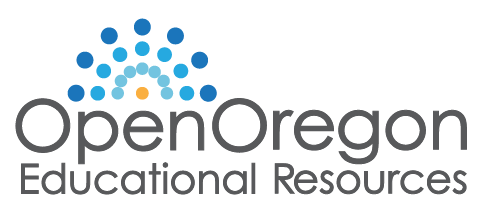
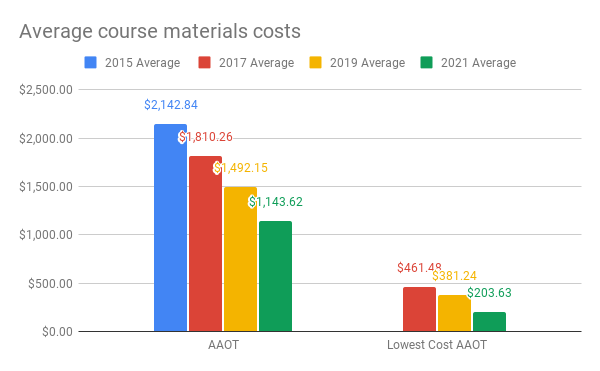
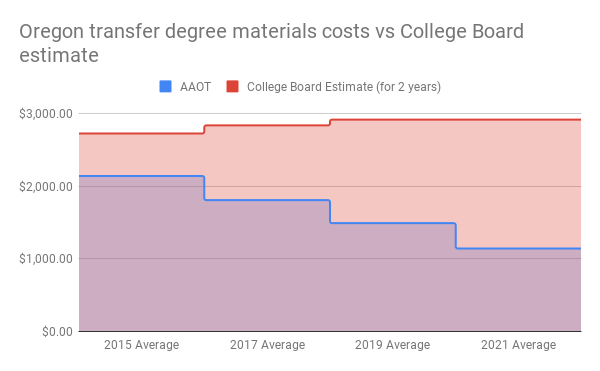
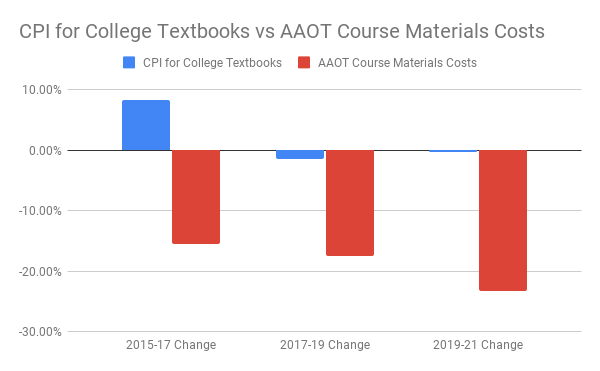
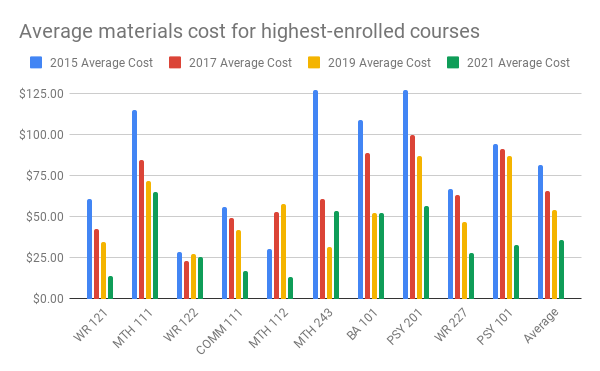
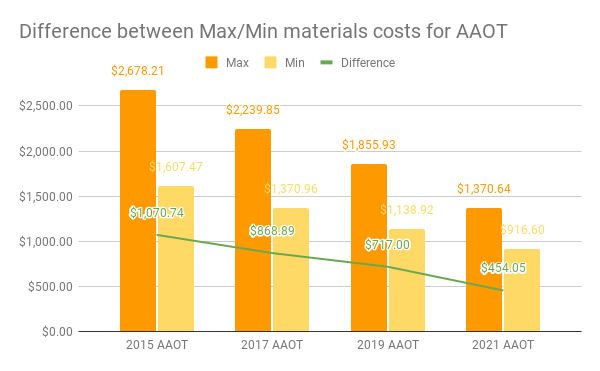
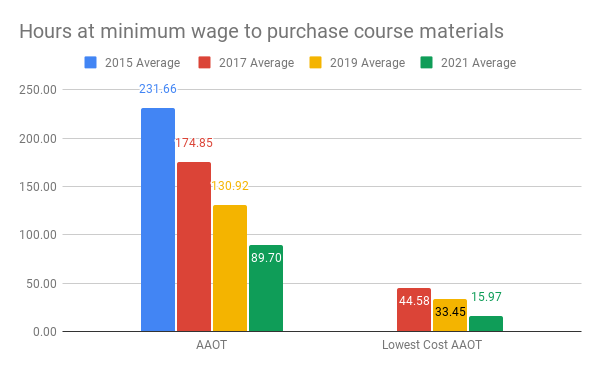
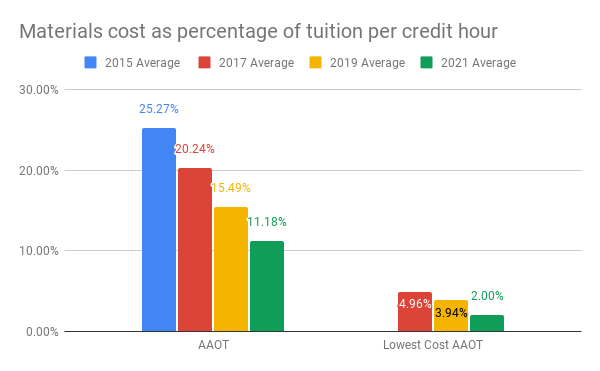
Pingback: Two Year Followup: Course material costs for four-year degrees at Oregon’s universities – openoregon.org